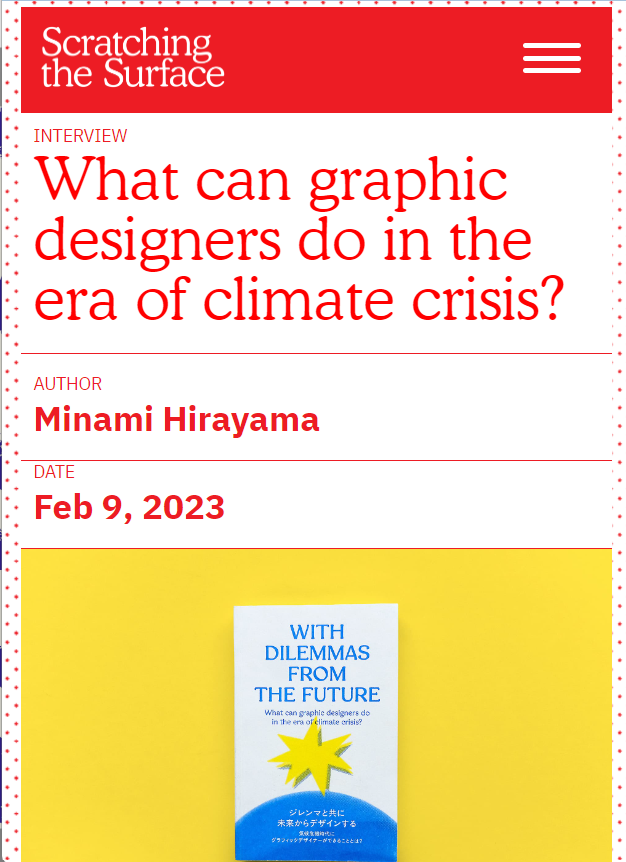BRIEF THREE
RESEARCH & CASE STUDY
The starting point.
What shapes me as a graphic designer, what’s affecting my community, what informs my practice, how can I help solve an issue?
My design practice is always informed in some way by where I live. The historical context of living in my province of Nova Scotia has afforded me a unique perspective — where an awareness and understanding of my presence is built into my daily life. Living in a country that has undergone colonization and cultural genocide of indigenous peoples, means you should – at the very least – be acutely aware of the spaces you move in. My identity as a designer is one that is aware of socio-political issues, cultural context and histories.
Over the last year my province has been hit with devastating wildfires, hurricanes, and flash floods that have displaced hundreds of residents as they lost their homes, land, and precious belongings. This has been exasperated not only by global warming, but also the abandonment of indigenous-led land care-taking practices. Now discarded, these traditions included controlled burns, crop cycling, and resource planning reduce the strain on the environment and reduce the effects of natural disasters. Global warming is an extreme threat to coastal communities like mine, as rising water levels bring flooding, erosion, and even landslides. Outside of my own community, and country, we’re seeing an increase in extreme weather conditions that threaten our homes, and way of life. A particularly dry summer month can lead to an increase in house fires, and heavy rain can see roof collapses or flooded ground floors. I looked for functional design opportunities inside this vast area, starting with my own experiences.
Design & Global Warming
I researched designers tackling or guided by the impact of global warming and found some valuable insights and methods of practice to incorporate to my own values as a designer.
This book project started from my dilemma of being a graphic designer and environmental activist. We graphic designers often create something to be consumed more and faster, so that companies can make an ever-growing profit. On the other hand, the state of the planet is deteriorating at speed from climate change which is caused by the extreme form of capitalism. I felt a strong urge to investigate if I could avoid being fuel for climate catastrophe while carrying on doing graphic design. - https://scratchingthesurface.fm/stories/2023-02-9-benedetta/
I found this excerpt of the interview particularly interesting:
I would like to ask you about the chart “Layers of Action”. It’s really interesting that you classified those actions we can do as a graphic designer. To make it even clearer, could you give us a concrete example of those actions based on three layers?
The first layer, the symbolic one, is widespread in design. This layer can be useful at times, but it is not the kind of work that will lead to the kind of structural change we need. It’s the layer when we call attention to sustainability, we do something “about it”, in a way that can or cannot have application in the real world. The light bulb made of grass, the poster that forms letters out of car emissions are an example of this layer. It also includes design that focuses on sustainability in its methodology but not its output. Clients of graphic design have a million ideas that fall within this layer, because it allows us to “perform” sustainability. But it can be useful to call attention on something. Graphic design work that presents content “about” sustainability also falls in this category.
The second layer focuses on material reality. It focuses on things that can be quantified as sustainable and deal with the supply chain of a design. The book made of recycled paper, the chair made of second-hand wood, the website made to save energy are examples of this layer. This layer is important, but it stops at material considerations. Communicative and aesthetic considerations are beyond its reach, it reduces design as a question of calculations most of the times. Most dangerously, it considers aesthetic value as being against sustainability, which would erase most of the world’s visual culture. This layer also remains invisible to the user of the design unless it is declared. That is why we need ecological paper stamps, or other declarations that make the user pay attention to the choices that were made – the “green labels”.
The third layer is the holistic one, where the most visible layer of the design, its aesthetic and communicative qualities, are what we work with to propose alternatives to exploitative approaches to form. It means asking ourselves questions about power and exploitation when we design, and make decisions based on that. This kind of work is harder to measure and “point to”. It is whatever form that questions dominant traditions in a way that expands our capacity to co-exist with one another.
CASE STUDY: BELONGINGS & LEGACY
Maud’s House.
With global warming effects threatening our communities, our land, our homes, our belongings, what is most important to your family history, and what is your legacy even without out those objects?
Maud Lewis was a prolific Nova Scotian folk artist, who had a life filled with many hardships and obstacles, but dedicated her life to bring joy to others, and her home, through painting. Maud lived in a home the size of a shed, with very little belongings. When she passed away, the home itself became an artefect. Maud’s home and few belongings have been carefully and painstakingly preserved, and now has a permanent place inside the Nova Scotia Art Gallery.
Her life’s story, and home, prove how you don’t need many belongings to have a legacy worth preserving. You can make your own history, even when you’re starting with nothing.
She adorned every surface of her small home, turning it into a work of art itself.






